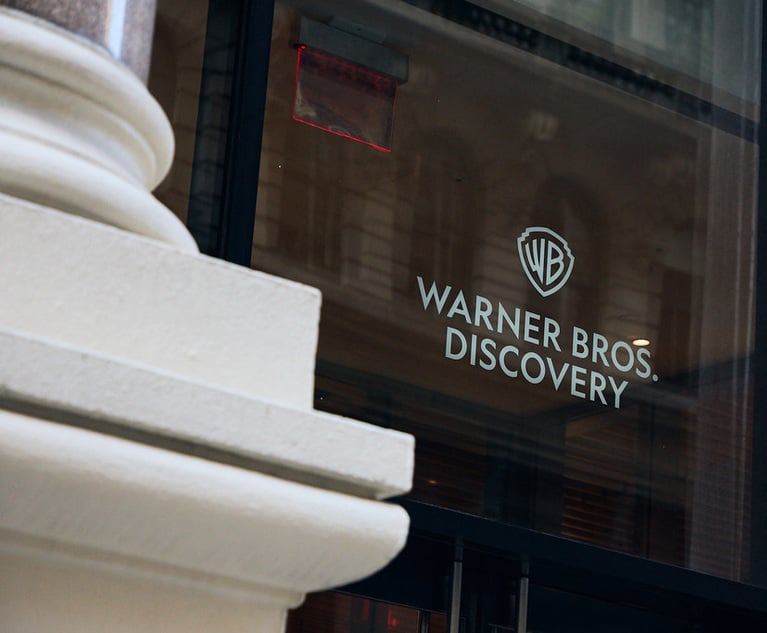5 reasons in-house counsel are reluctant to make the predictive coding leap
The fundamentals of litigation practice have remained the same for decades.
July 30, 2013 at 04:00 AM
6 minute read
The original version of this story was published on Law.com
The fundamentals of litigation practice have remained the same for decades—attorneys gather facts, assemble a narrative and advocate that narrative to a tribunal. What has changed, however, is the media on which we find the facts to support our cases. Two decades ago, almost all information was supported by paper documents. Electronic data was part, but not the focus, of discovery efforts. Today, the inverse is true: Our clients' businesses are based almost exclusively on electronic data. And because it requires less “storage” space, electronic data is preserved at a much higher rate than paper documents. As the media of discovery has changed, we must adapt and embrace new discovery approaches, methods and tools.
Predictive coding is one such tool, and it is quickly making a name for itself by promising more effective—cheaper, faster, more precise and more consistent—results than manual document review. Proponents of advanced review technology argue that predictive coding is extremely effective at managing the ever-increasing breadth and cost of electronic discovery. But, as predictive coding continues to quickly transform the landscape of large-scale discovery, our experience has been that some in-house counsel (as well as some veteran litigators) are still reluctant to make the leap. Here are five reasons why we think this reluctance exists and our commentary on how you can better understand, trust and employ this predictive coding technology.
1. “Change is scary”
Lawyers resist change. Indeed, our jurisprudential system is predicated on using precedence to inform our course. We are trained to trust what we know and what has been tested in the courts. Because predictive coding is unfamiliar to many lawyers and judges, it is not difficult to understand the initial distrust of a document-review protocol that does not involve lawyers conducting a page-by-page manual review.
But predictive coding, properly understood, follows a logical continuum of leveraging technology to achieve the same objectives that have always existed. In the past, human reviewers looked for patterns when reviewing documents, made determinations based on their analysis, and then, ideally, applied decisions in the same way across a document set. In essence, this is exactly what predictive coding does—it applies the decisions of human reviewers across a universe of documents. Further, due to the mountains of electronic data that need to be assessed, often very quickly, in modern litigation, the amount of data we encounter in cases today cannot be reviewed effectively and efficiently by human beings in a traditional manner. Tools like predictive coding provide us with a proven strategy for dealing with this challenge.
Moreover, it should make you feel better that the use of predictive coding has gained increasing acceptance within the industry. The Department of Justice has endorsed it in some of our cases. And more importantly, state and federal judges have begun to embrace the use of this technology, even requiring it in some instances.
2. “We cannot spend that much money”
Unsurprisingly, clients rarely want to spend their finite legal budgets on things they do not need. Big-ticket items attract significant attention from in-house counsel, and predictive coding can appear at first glance to be a big-ticket item. This is a complete misconception. Although there is a front-loaded cost to engaging the necessary technology, it is dwarfed by the ultimate cost savings realized and the efficiencies the technology lends to the review process. Traditional document review is usually far more expensive, often requiring armies of document reviewers and multiple rounds and levels of review. The use of predictive coding, on the other hand, allows for determinations to be applied more quickly, accurately and uniformly to a data set.
3. “Can this technology really be trusted?”
Predictive coding technology is relatively new. Undoubtedly, some lawyers have visions of HAL refusing to open the pod-bay doors. But we have already placed trust in computers in other ways in our profession. When we run a key-number search on Westlaw or LexisNexis, we trust that the technology will give us all of the cases with headnotes for that key number. Similarly, when we perform a corporate-name search in a secretary-of-state database, we trust that the database will provide us with correct results. Though obviously more complex than these examples, predictive coding represents a logical next step of lawyers partnering with technology to get the job done. And while it can be difficult to grasp the minutiae of how the technology behind predictive coding actually works, the bottom line is that it does—very well. Studies have shown that predictive coding's multi-dimensional “thinking” and continuous fine-tuning provide more accurate and consistent results than traditional manual review.
We must also remember that predictive coding is a tool designed to assist lawyers, not to completely take over. This technology does not replace human effort with a magic button that you push and voila! To the contrary, there needs to be a solid workflow in place in which human expertise and the technology work as a team. Seasoned lawyers who are highly knowledgeable about the substantive issues in the case must make the initial decisions, which are then captured, analyzed and used to teach the computer to identify, with increasing precision, conceptually similar documents across the data set. Human involvement is integral to the process, from beginning to end.
4. “Predictive coding is only for really complicated cases”
Predictive coding's usefulness does not squarely correlate to the level of complexity of a case. More than anything else, this technology manages large volumes of data efficiently. Accordingly, predictive coding's utility is governed more by the amount of data in a case because there must be enough information from which the technology can learn. Counsel should carefully assess, on a case-by-case basis, whether this technology—and its costs—are appropriate given the amount of data to be reviewed.
5. “Isn't this just a passing fad?”
Put simply, “No.” Like the volumes of electronic data that bury litigants in modern litigation, review tools like predictive coding are here to stay. Accordingly, it is critical that lawyers take the steps necessary to understand these tools so that they can be deployed in the most advantageous way possible.
This content has been archived. It is available through our partners, LexisNexis® and Bloomberg Law.
To view this content, please continue to their sites.
Not a Lexis Subscriber?
Subscribe Now
Not a Bloomberg Law Subscriber?
Subscribe Now
NOT FOR REPRINT
© 2025 ALM Global, LLC, All Rights Reserved. Request academic re-use from www.copyright.com. All other uses, submit a request to [email protected]. For more information visit Asset & Logo Licensing.
You Might Like
View All


SEC Puts Beat Down on Ex-Wrestling CEO Vince McMahon for Not Reporting Settlements
3 minute readTrending Stories
- 1'It's Not Going to Be Pretty': PayPal, Capital One Face Novel Class Actions Over 'Poaching' Commissions Owed Influencers
- 211th Circuit Rejects Trump's Emergency Request as DOJ Prepares to Release Special Counsel's Final Report
- 3Supreme Court Takes Up Challenge to ACA Task Force
- 4'Tragedy of Unspeakable Proportions:' Could Edison, DWP, Face Lawsuits Over LA Wildfires?
- 5Meta Pulls Plug on DEI Programs
Who Got The Work
Michael G. Bongiorno, Andrew Scott Dulberg and Elizabeth E. Driscoll from Wilmer Cutler Pickering Hale and Dorr have stepped in to represent Symbotic Inc., an A.I.-enabled technology platform that focuses on increasing supply chain efficiency, and other defendants in a pending shareholder derivative lawsuit. The case, filed Oct. 2 in Massachusetts District Court by the Brown Law Firm on behalf of Stephen Austen, accuses certain officers and directors of misleading investors in regard to Symbotic's potential for margin growth by failing to disclose that the company was not equipped to timely deploy its systems or manage expenses through project delays. The case, assigned to U.S. District Judge Nathaniel M. Gorton, is 1:24-cv-12522, Austen v. Cohen et al.
Who Got The Work
Edmund Polubinski and Marie Killmond of Davis Polk & Wardwell have entered appearances for data platform software development company MongoDB and other defendants in a pending shareholder derivative lawsuit. The action, filed Oct. 7 in New York Southern District Court by the Brown Law Firm, accuses the company's directors and/or officers of falsely expressing confidence in the company’s restructuring of its sales incentive plan and downplaying the severity of decreases in its upfront commitments. The case is 1:24-cv-07594, Roy v. Ittycheria et al.
Who Got The Work
Amy O. Bruchs and Kurt F. Ellison of Michael Best & Friedrich have entered appearances for Epic Systems Corp. in a pending employment discrimination lawsuit. The suit was filed Sept. 7 in Wisconsin Western District Court by Levine Eisberner LLC and Siri & Glimstad on behalf of a project manager who claims that he was wrongfully terminated after applying for a religious exemption to the defendant's COVID-19 vaccine mandate. The case, assigned to U.S. Magistrate Judge Anita Marie Boor, is 3:24-cv-00630, Secker, Nathan v. Epic Systems Corporation.
Who Got The Work
David X. Sullivan, Thomas J. Finn and Gregory A. Hall from McCarter & English have entered appearances for Sunrun Installation Services in a pending civil rights lawsuit. The complaint was filed Sept. 4 in Connecticut District Court by attorney Robert M. Berke on behalf of former employee George Edward Steins, who was arrested and charged with employing an unregistered home improvement salesperson. The complaint alleges that had Sunrun informed the Connecticut Department of Consumer Protection that the plaintiff's employment had ended in 2017 and that he no longer held Sunrun's home improvement contractor license, he would not have been hit with charges, which were dismissed in May 2024. The case, assigned to U.S. District Judge Jeffrey A. Meyer, is 3:24-cv-01423, Steins v. Sunrun, Inc. et al.
Who Got The Work
Greenberg Traurig shareholder Joshua L. Raskin has entered an appearance for boohoo.com UK Ltd. in a pending patent infringement lawsuit. The suit, filed Sept. 3 in Texas Eastern District Court by Rozier Hardt McDonough on behalf of Alto Dynamics, asserts five patents related to an online shopping platform. The case, assigned to U.S. District Judge Rodney Gilstrap, is 2:24-cv-00719, Alto Dynamics, LLC v. boohoo.com UK Limited.
Featured Firms
Law Offices of Gary Martin Hays & Associates, P.C.
(470) 294-1674
Law Offices of Mark E. Salomone
(857) 444-6468
Smith & Hassler
(713) 739-1250







